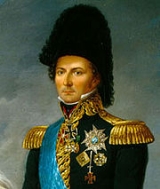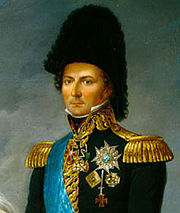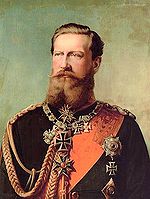
Grand Cross of the Iron Cross
Encyclopedia
The Grand Cross of the Iron Cross was a decoration intended for victorious generals of the Prussia
n Army
and its allies
. It was the highest class of the Iron Cross
. Along with the Iron Cross 1st and 2nd Class, the Grand Cross was founded on March 10, 1813, during the Napoleonic Wars
. It was renewed in 1870 for the Franco-Prussian War
and again in 1914 for World War I
. In 1939, when Adolf Hitler
renewed the Iron Cross as a German, rather than Prussian, decoration, the Grand Cross was again renewed.
The Grand Cross of the Iron Cross was twice the size of the Iron Cross and was worn from a ribbon around the neck. The later Knight's Cross of the Iron Cross
, instituted in 1939, was also worn from the neck; it was smaller than the Grand Cross but larger than the Iron Cross.
 Five men received the 1813 Grand Cross of the Iron Cross for actions during the Napoleonic Wars:
Five men received the 1813 Grand Cross of the Iron Cross for actions during the Napoleonic Wars:
 The Iron Cross was renewed on July 19, 1870, for the Franco-Prussian War
The Iron Cross was renewed on July 19, 1870, for the Franco-Prussian War
. Nine men received the 1870 Grand Cross of the Iron Cross for service during that war. Seven Grand Crosses were awarded on March 22, 1871, to:
Kaiser Wilhelm I received the Grand Cross on June 16, 1871, and Friedrich Franz II, Grand Duke of Mecklenburg-Schwerin, received it on December 4, 1871. The Kaiser was supreme commander of the Prussian Army, and Moltke was Chief of the General Staff. The others were senior combat commanders of the Prussian Army (Crown Prince Albert initially commanded the Saxon Army as a corps under a Prussian field army, but later took command of a combined Prussian/Saxon field army).
reinstituted the Iron Cross as a German
decoration in September 1939, with the Grand Cross again as the highest grade (above the various classes of the Knight's Cross
). Hermann Göring
became the only recipient of the Grand Cross of the Iron Cross during World War II
when it was awarded to him on July 19, 1940.
The Grand Cross - when Hitler originally re-instituted it - was supposed to have been outlined in gold
, but this was changed to silver
before Göring was awarded his. Göring - who loved amassing medals - felt that the Grand Cross he received from Hitler was not really grand enough, so he had copies made - one with platinum
edges - which he wore. The original awarded Grand Cross was destroyed in an air raid in 1943. Göring was wearing his platinum-edged one at the time of his surrender in 1945. Shortly before his suicide, Hitler deprived Göring of the Grand Cross because he felt betrayed by him. Also, Göring had the curious habit of not wearing the Grand Cross at times (generally whenever the Luftwaffe was not performing well).
The award case for the 1939 Grand Cross had a red leather exterior, which was embossed with a gold Reich Eagle. The bottom interior of the case was lined in black velvet.
An even higher decoration, the Star of the Grand Cross of the Iron Cross
, was intended to be presented to the most successful German general of World War II once Germany achieved victory. Awarded only twice (to Field Marshals Gebhard Leberecht von Blücher
and Paul von Hindenburg
), a prototype 1939 Star was discovered by the Allies in 1945. It is currently on display with Göring's Reichsmarschall baton in the West Point Military Collection.
Prussia
Prussia was a German kingdom and historic state originating out of the Duchy of Prussia and the Margraviate of Brandenburg. For centuries, the House of Hohenzollern ruled Prussia, successfully expanding its size by way of an unusually well-organized and effective army. Prussia shaped the history...
n Army
Army
An army An army An army (from Latin arma "arms, weapons" via Old French armée, "armed" (feminine), in the broadest sense, is the land-based military of a nation or state. It may also include other branches of the military such as the air force via means of aviation corps...
and its allies
Allies
In everyday English usage, allies are people, groups, or nations that have joined together in an association for mutual benefit or to achieve some common purpose, whether or not explicit agreement has been worked out between them...
. It was the highest class of the Iron Cross
Iron Cross
The Iron Cross is a cross symbol typically in black with a white or silver outline that originated after 1219 when the Kingdom of Jerusalem granted the Teutonic Order the right to combine the Teutonic Black Cross placed above a silver Cross of Jerusalem....
. Along with the Iron Cross 1st and 2nd Class, the Grand Cross was founded on March 10, 1813, during the Napoleonic Wars
Napoleonic Wars
The Napoleonic Wars were a series of wars declared against Napoleon's French Empire by opposing coalitions that ran from 1803 to 1815. As a continuation of the wars sparked by the French Revolution of 1789, they revolutionised European armies and played out on an unprecedented scale, mainly due to...
. It was renewed in 1870 for the Franco-Prussian War
Franco-Prussian War
The Franco-Prussian War or Franco-German War, often referred to in France as the 1870 War was a conflict between the Second French Empire and the Kingdom of Prussia. Prussia was aided by the North German Confederation, of which it was a member, and the South German states of Baden, Württemberg and...
and again in 1914 for World War I
World War I
World War I , which was predominantly called the World War or the Great War from its occurrence until 1939, and the First World War or World War I thereafter, was a major war centred in Europe that began on 28 July 1914 and lasted until 11 November 1918...
. In 1939, when Adolf Hitler
Adolf Hitler
Adolf Hitler was an Austrian-born German politician and the leader of the National Socialist German Workers Party , commonly referred to as the Nazi Party). He was Chancellor of Germany from 1933 to 1945, and head of state from 1934 to 1945...
renewed the Iron Cross as a German, rather than Prussian, decoration, the Grand Cross was again renewed.
The Grand Cross of the Iron Cross was twice the size of the Iron Cross and was worn from a ribbon around the neck. The later Knight's Cross of the Iron Cross
Knight's Cross of the Iron Cross
The Knight's Cross of the Iron Cross was a grade of the 1939 version of the 1813 created Iron Cross . The Knight's Cross of the Iron Cross was the highest award of Germany to recognize extreme battlefield bravery or successful military leadership during World War II...
, instituted in 1939, was also worn from the neck; it was smaller than the Grand Cross but larger than the Iron Cross.
1813 Grand Cross

- Gebhard Leberecht von BlücherGebhard Leberecht von BlücherGebhard Leberecht von Blücher, Fürst von Wahlstatt , Graf , later elevated to Fürst von Wahlstatt, was a Prussian Generalfeldmarschall who led his army against Napoleon I at the Battle of the Nations at Leipzig in 1813 and at the Battle of Waterloo in 1815 with the Duke of Wellington.He is...
, commander of Prussian forces at the Battle of WaterlooBattle of WaterlooThe Battle of Waterloo was fought on Sunday 18 June 1815 near Waterloo in present-day Belgium, then part of the United Kingdom of the Netherlands...
, later elevated to the Star of the Grand Cross of the Iron CrossStar of the Grand Cross of the Iron CrossThe Star of the Grand Cross of the Iron Cross was the highest military decoration of the Kingdom of Prussia and the German Empire. It was considered a senior decoration to the Grand Cross of the Iron Cross.... - Friedrich Wilhelm von BülowFriedrich Wilhelm Freiherr von BülowFriedrich Wilhelm Freiherr von Bülow, Graf von Dennewitz was a Prussian general of the Napoleonic Wars.-Early life:...
- Crown Prince Charles John of Sweden (Jean-Baptiste Bernadotte)Charles XIV John of SwedenCharles XIV & III John, also Carl John, Swedish and Norwegian: Karl Johan was King of Sweden and King of Norway from 1818 until his death...
- earlier a Marshal under Napoleon, after becoming regent and crown prince of Sweden, he joined the Sixth Coalition against Napoleon. - Bogislav Friedrich Emanuel von TauentzienBogislav Friedrich Emanuel von TauentzienBogislav Friedrich Emanuel Graf Tauentzien von Wittenberg was a Prussian general of the Napoleonic Wars....
- Ludwig Yorck von Wartenburg.
1870 Grand Cross

Franco-Prussian War
The Franco-Prussian War or Franco-German War, often referred to in France as the 1870 War was a conflict between the Second French Empire and the Kingdom of Prussia. Prussia was aided by the North German Confederation, of which it was a member, and the South German states of Baden, Württemberg and...
. Nine men received the 1870 Grand Cross of the Iron Cross for service during that war. Seven Grand Crosses were awarded on March 22, 1871, to:
- Crown Prince Albert of SaxonyAlbert of SaxonyAlbert of Saxony may refer to:* Albert of Saxony * Albert I, Duke of Saxony * Albert, Duke of Saxony * Prince Albert of Saxony, Duke of Teschen * Albert of Saxony...
- August Karl von GoebenAugust Karl von GoebenAugust Karl von Göben was a Prussian infantry general. He was awarded the Iron Cross for his service in the Franco-Prussian War.-Early career:...
- Edwin Freiherr von ManteuffelEdwin Freiherr von ManteuffelEdwin Freiherr von Manteuffel was a German Generalfeldmarschall noted for his victories in the Franco-Prussian War....
- Helmuth Graf von Moltke the ElderHelmuth von Moltke the ElderHelmuth Karl Bernhard Graf von Moltke was a German Field Marshal. The chief of staff of the Prussian Army for thirty years, he is regarded as one of the great strategists of the latter 19th century, and the creator of a new, more modern method of directing armies in the field...
- Prince Frederick Charles of PrussiaPrince Frederick Charles of PrussiaPrince Friedrich Carl Nicolaus of Prussia was the son of Prince Charles of Prussia and his wife Princess Marie of Saxe-Weimar-Eisenach . Prince Frederick Charles was a grandson of King Frederick William III of Prussia and a nephew of Frederick William IV and William I...
. - Crown Prince Friedrich Wilhelm of PrussiaFrederick III, German EmperorFrederick III was German Emperor and King of Prussia for 99 days in 1888, the Year of the Three Emperors. Friedrich Wilhelm Nikolaus Karl known informally as Fritz, was the only son of Emperor William I and was raised in his family's tradition of military service...
(later Kaiser Friedrich III) - August Graf von WerderKarl Wilhelm Friedrich August Leopold, Count von WerderKarl Wilhelm Friedrich August Leopold Graf von Werder was a Prussian general.Werder was born in Schloßberg near Norkitten in the Province of East Prussia. He entered the Prussian Gardes du Corps in 1825, transferring the following year into the Guard Infantry, with which he served for many years...
Kaiser Wilhelm I received the Grand Cross on June 16, 1871, and Friedrich Franz II, Grand Duke of Mecklenburg-Schwerin, received it on December 4, 1871. The Kaiser was supreme commander of the Prussian Army, and Moltke was Chief of the General Staff. The others were senior combat commanders of the Prussian Army (Crown Prince Albert initially commanded the Saxon Army as a corps under a Prussian field army, but later took command of a combined Prussian/Saxon field army).
1914 Grand Cross
The Iron Cross was renewed again on August 5, 1914. There were five recipients of the 1914 Grand Cross in the First World War:- Kaiser Wilhelm II
- Paul von HindenburgPaul von HindenburgPaul Ludwig Hans Anton von Beneckendorff und von Hindenburg , known universally as Paul von Hindenburg was a Prussian-German field marshal, statesman, and politician, and served as the second President of Germany from 1925 to 1934....
, later elevated to the Star of the Grand Cross of the Iron CrossStar of the Grand Cross of the Iron CrossThe Star of the Grand Cross of the Iron Cross was the highest military decoration of the Kingdom of Prussia and the German Empire. It was considered a senior decoration to the Grand Cross of the Iron Cross.... - Erich LudendorffErich LudendorffErich Friedrich Wilhelm Ludendorff was a German general, victor of Liège and of the Battle of Tannenberg...
- Prince Leopold of BavariaPrince Leopold of BavariaLeopold Maximilian Joseph Maria Arnulf, Prinz von Bayern was born in Munich, the son of Prince Regent Luitpold of Bavaria and his wife Archduchess Augusta of Austria...
- August von MackensenAugust von MackensenAnton Ludwig August von Mackensen , born August Mackensen, was a German soldier and field marshal. He commanded with success during the First World War and became one of the German Empire's most prominent military leaders. After the Armistice, Mackensen was interned for a year...
1939 Grand Cross
Adolf HitlerAdolf Hitler
Adolf Hitler was an Austrian-born German politician and the leader of the National Socialist German Workers Party , commonly referred to as the Nazi Party). He was Chancellor of Germany from 1933 to 1945, and head of state from 1934 to 1945...
reinstituted the Iron Cross as a German
Germany
Germany , officially the Federal Republic of Germany , is a federal parliamentary republic in Europe. The country consists of 16 states while the capital and largest city is Berlin. Germany covers an area of 357,021 km2 and has a largely temperate seasonal climate...
decoration in September 1939, with the Grand Cross again as the highest grade (above the various classes of the Knight's Cross
Knight's Cross of the Iron Cross
The Knight's Cross of the Iron Cross was a grade of the 1939 version of the 1813 created Iron Cross . The Knight's Cross of the Iron Cross was the highest award of Germany to recognize extreme battlefield bravery or successful military leadership during World War II...
). Hermann Göring
Hermann Göring
Hermann Wilhelm Göring, was a German politician, military leader, and a leading member of the Nazi Party. He was a veteran of World War I as an ace fighter pilot, and a recipient of the coveted Pour le Mérite, also known as "The Blue Max"...
became the only recipient of the Grand Cross of the Iron Cross during World War II
World War II
World War II, or the Second World War , was a global conflict lasting from 1939 to 1945, involving most of the world's nations—including all of the great powers—eventually forming two opposing military alliances: the Allies and the Axis...
when it was awarded to him on July 19, 1940.
The Grand Cross - when Hitler originally re-instituted it - was supposed to have been outlined in gold
Gold
Gold is a chemical element with the symbol Au and an atomic number of 79. Gold is a dense, soft, shiny, malleable and ductile metal. Pure gold has a bright yellow color and luster traditionally considered attractive, which it maintains without oxidizing in air or water. Chemically, gold is a...
, but this was changed to silver
Silver
Silver is a metallic chemical element with the chemical symbol Ag and atomic number 47. A soft, white, lustrous transition metal, it has the highest electrical conductivity of any element and the highest thermal conductivity of any metal...
before Göring was awarded his. Göring - who loved amassing medals - felt that the Grand Cross he received from Hitler was not really grand enough, so he had copies made - one with platinum
Platinum
Platinum is a chemical element with the chemical symbol Pt and an atomic number of 78. Its name is derived from the Spanish term platina del Pinto, which is literally translated into "little silver of the Pinto River." It is a dense, malleable, ductile, precious, gray-white transition metal...
edges - which he wore. The original awarded Grand Cross was destroyed in an air raid in 1943. Göring was wearing his platinum-edged one at the time of his surrender in 1945. Shortly before his suicide, Hitler deprived Göring of the Grand Cross because he felt betrayed by him. Also, Göring had the curious habit of not wearing the Grand Cross at times (generally whenever the Luftwaffe was not performing well).
The award case for the 1939 Grand Cross had a red leather exterior, which was embossed with a gold Reich Eagle. The bottom interior of the case was lined in black velvet.
An even higher decoration, the Star of the Grand Cross of the Iron Cross
Star of the Grand Cross of the Iron Cross
The Star of the Grand Cross of the Iron Cross was the highest military decoration of the Kingdom of Prussia and the German Empire. It was considered a senior decoration to the Grand Cross of the Iron Cross....
, was intended to be presented to the most successful German general of World War II once Germany achieved victory. Awarded only twice (to Field Marshals Gebhard Leberecht von Blücher
Gebhard Leberecht von Blücher
Gebhard Leberecht von Blücher, Fürst von Wahlstatt , Graf , later elevated to Fürst von Wahlstatt, was a Prussian Generalfeldmarschall who led his army against Napoleon I at the Battle of the Nations at Leipzig in 1813 and at the Battle of Waterloo in 1815 with the Duke of Wellington.He is...
and Paul von Hindenburg
Paul von Hindenburg
Paul Ludwig Hans Anton von Beneckendorff und von Hindenburg , known universally as Paul von Hindenburg was a Prussian-German field marshal, statesman, and politician, and served as the second President of Germany from 1925 to 1934....
), a prototype 1939 Star was discovered by the Allies in 1945. It is currently on display with Göring's Reichsmarschall baton in the West Point Military Collection.

